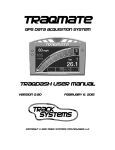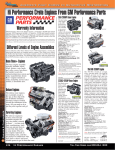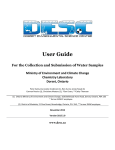Download Voice News October 2 2008 - Section 3
Transcript
SECTION 3 • VOICE NEWS, Thursday, October 2, 2008 - Page 29 Automotive Alchemy Eagle man turns junk into gold High cost of diesel fuel takes toll on truckers’income Kent Halvorsen recently got his hands dirty in the innards of a ‘64 Chevelle Super Sport at his shop in Eagle. “I may be old, but I’m still fast,” he said. Photo by Logan Seacrest Lynette and Ron Schuster, of rural Martell, are two area truckers who have been dealing with high diesel prices. Photo by Mark Mahoney By Mark Mahoney Ron and Lynette Schuster are on the road a lot, usually on a weekly basis, so the cost of fuel is a concern for them. The rural Martell couple’s livelihood depends on being able to take their red 2002 Freightliner semi tractor and white trailer on the road every week to deliver a load to California and then picking up another freight and bringing it back to Nebraska. Ron and Lynette have been the owner-operators of a semi for the past two years, but running their own truck hasn’t been easy. Ron said he loves driving the semi, but some weeks require tightening of the metaphorical belt financially. “It makes it tough with the fuel prices the way they are,” he said. “It’s rough some weeks, that’s for sure.” Ron and Lynette, like other truckers, have seen the price of diesel shoot up over the past few years. During the past two years, the cost of diesel across the state has fluctuated between $2.58 per gallon in October 2006 and $3.96 per gallon near the end of this past September, according to the Nebraska Energy Office. Ron said he recently paid $3.83 per gallon on one of his trips west on Interstate 80, the cheapest price he’s seen. On the West Coast, the cost of fuel is usually higher. “In California, I’ve paid $5.35 a gallon,” he said. Larry Johnson, president of the Nebraska Trucking Association, said diesel prices across Nebraska spiked close to $5 per gallon this past summer. He added that the reason was because President George W. Bush, under pressure from different political forces, threatened to open oil reserves around New Orleans, Louisiana, and throughout the Gulf of Mexico, which would allow large amounts of the strategic oil reserves into the marketplace. “What that would do, if speculators are buying (crude-oil) futures assuming they will go up, if the government dumps a lowpriced fuel into the marketplace, all those speculators would quickly lose, the price would be driven down and the futures would be less than what they were betting on,” he said. Johnson said the reason for the recent decline in diesel prices is non-commercial vehicles have cut back in their use of fuel by the billions of gallons through more efficient vehicles, carpooling and other conservation methods, which has caused gasoline prices to go down too. Scott Pope, operations manager and dispatcher for Buhr Trucking in Adams, said he hopes diesel prices keep decreasing. “It’s looking good now (for truckers) that diesel fuel is going down,” he said. Continued on Page 32 By Logan Seacrest If you can name it, Kent Halvorsen has probably worked on it. For the past 18 years, Halvorsen has been bringing cars back to life in his Eagle garage. Three years ago, he opened a new shop on the east end of town. The added room has enhanced Halvorsen’s ability to perform miracles, raising the automotive dead like a wrench-wielding Dr. Frankenstein. Currently on the operating table is a hollowed out Camaro, recovering from surgery. Halvorsen recently cut off the entire rear section of the vehicle, grafting on a new tail from an unlucky donor. With cars in various states of restoration on the floor, scale models in display cases and racing posters hung on the walls; the shop looks a cross between a laboratory, a Jiffy Lube and a kid’s clubhouse. Which makes his company’s name, Halvorsen’s Boys Toys, very appropriate. Catering mostly to the hobbyist crowd, Halvorsen’s taste is decidedly vintage – the older, and more rare, the better. “We call our cars toys, and I end up working on a lot of people’s personal toys,” he said. A self-taught mechanic who doesn’t take direction especially well, Halvorsen enjoys being his own boss. Much of his business comes from Lincoln car collectors, although the shop is not above working on the occasional family Taurus. If he’s honest with himself though, Halvorsen needs a challenge that changing oil on minivans just cannot provide. “I love working on old cars, because making something out of nothing is an amazing feeling,” he said. It’s true that anybody can take something apart, but it takes special expertise to put these complex machines back together. Halvorsen can handle anything mechanical on a car, be it installing the engine, tweaking the brakes, or running the electrical wiring. If it once moved, Halvorsen can make it do so again. Something of a collector himself, Halvorsen owns a ’62 Dodge Dart (his pride and joy), a ’70 Yenko Deuce (one of only 178 in existence) and a ’67 Camaro (which has been converted into a drag racer). A casual observer might be fooled, but none of these cars are in absolute mint condition. Halvorsen said restoring classic cars to factory floor precision is sometimes impossible. “There are some cars that nobody even knows what the original was really like,” he said. That said, Halvorsen rarely turns anyone away. If a car is unique and strange enough, Halvorsen has been known to work on it for free, “just for the joy of playing with it.” Recently, a man from Lincoln brought in an old NASCAR, once driven by Joe Nemechek. “What are the chances of having a NASCAR sitting here in Eagle, Nebraska?” Halvorsen said. Not all of Halvorsen’s cars are mere showpieces though. For the last three years, Halvorsen and his son Jerrid have been drag racing on a track 280 miles away in Eddieville, Iowa. As members of the Ozark Mountain Stick Shifters, the cars they race must have manual transmissions and absolutely no electronics. “Automatics may be easier and brake down less often, but we’re not always about ‘easy’ around here,” Crew Chief Halvorsen said. Sitting in the middle of the garage is a gleaming red ’64 Chevelle Super Sport. It’s owned by Halversen’s brother, who does the body work as a member of the Boys Toys crew. The Chevelle used to be a pile of junk, but after a trip through the Halvorsen restoration machine, now looks like it just popped off the assembly line – a prime example of the spectacular results Halvorsen can achieve. “I don’t want to work on just any old car,” he said. “I want to work on cars that are really, really, cool.” Page 30 - SECTION 3 • VOICE NEWS, Thursday, October 2, 2008 Shopping for hybrids: It may not be the right move Trunk essentials: don’t drive off without them Before loading up the car for your next road trip, get rid of the junk, but make sure you don’t dump the items that every driver should have on the road-from the basic essentials to the ultimate car accessories. When it comes to preparing for the unexpected and preventing roadside trouble, your car trunk should include these items: • First-Aid Kit- Better to be safe than sorry. A first-aid kit is a must for every car. • Flashlight- In case problems arise after dark, make sure to have a flashlight with fresh batteries. • Jumper Cables- Whether it’s your battery or a fellow driver’s, when it needs a jolt of energy, it pays to have jumper cables in the trunk. Husky offers a Portable AC/DC Power System available for less than $90. It can jump-start your car or truck, run any 120v or 12v product (think TVs, cell phones and car vacs) and it can inflate tires. • Tire Pressure Gauge- Properly inflated tires help increase rider comfort and save fuel. Keep a tire pressure gauge on hand for a quick check at any time. • Spare Tire and Jack- Tires go flat in the worst of times, so before you go anywhere make sure you’ve got a working jack and the spare tire is fully inflated. • One-Gallon Gas Can and Siphon Hose- Forgot to fill up the tank? A gas can and siphon hose ensure that you can load up enough gas to get to the nearest gas station. • Hand Tools- Whether you’re a mechanic or not, keeping some hand tools in your trunk can help out in a pinch. Try Husky’s 30-piece Ratchet and Socket Set for $24.99. • Blanket or Towel- In case you get stuck waiting for help, keep a blanket in your car to keep warm. You can also throw a towel on the ground when changing a flat, avoiding damage to your pants and shoes. Hybrid cars are helping drive the auto market, with sales of the green vehicles rising 38 percent last year alone, according to the Associated Press. As drivers continue to face sticker shock at the pump, experts don’t expect hybrid sales to cool off anytime soon. But is a hybrid vehicle right for you? It depends on what you’re looking for in your car, the way you drive and what you hope to spend. “Hybrids can be a silver bullet to high gas bills. But some hybrids don’t boost fuel economy much at all,” says Marty Padgett, editor of TheCarConnection.com. He offers these reasons to buy-and not to buya hybrid: The Right Reasons • To replace a dying car: If you’re buying a new vehicle for other reasons, it’s the right time to consider a hybrid. “If you just want to ditch a big SUV, don’t-the used values are dropping fast,” Padgett warns. • For tax breaks: While the Prius is no longer eligible for tax breaks, hybrids such as the Mazda Tribute qualify for up to a $3,000 tax credit. • For company perks: Companies from Bank of America to Timberland give money or parking privileges to employees who own hybrids. • For high occupancy (HOV) lane rights: “Some cities let hybrid owners drive in the HOV lanes,” Padgett says. • To downsize: Trading a Chevy Tahoe for a hybrid version saves some gas-but trading it for a Honda Civic Hybrid gives you more bang for your buck. The Wrong Reasons • To save money now: You won’t save money at first. A Honda Civic Hybrid costs about $2,500 more than the gas-only version. Even at $4 a gallon, it could take four years to repay the hybrid cost. • To get lower service bills: It might use less gas, but at some point your hybrid will need its batteries replaced, and it still needs regular service, including oil changes, new tires and new brakes. • For regular-car performance: Hybrids feel mostly like normal carsbut generally have less sensitive steering and brakes. • For the fuel economy on the sticker: Even with changes to the EPA’s testing cycle, those window stickers still have optimistic city and highway ratings. • To be cool: Fashions are fickle. For more information on hybrid vehicles, including reviews of specific models, details on tax breaks and other incentives, go to the Web site TheCarConnection.com. Keep your cool while on the road With so many people on the road during peak vacation months, it may be a good time to brush up on what you should do in the event you’re involved in a crash. Preparedness starts before you leave the driveway: • Put a disposable camera and pen and paper in your glove box. Car insurance claims can be settled faster if there’s a good record of what happened. If you can take photographs or collect license plate numbers, or even names and phone numbers of witnesses, these can all help your insurance company establish facts faster. If you’re involved in a crash: • Move your vehicle out of the roadway, if you can. If your car is able to be driven, move it off the road a safe distance. By getting off the road, you can help to avoid a second collision. • Turn on your flashers or your lights. You want to be certain your vehicle is visible to other drivers. • Check yourself and your passengers for injuries. If someone is injured, call 911 immediately. • Call local police to report the crash. • Call your insurance company to report the crash. The earlier your insurance company knows about the crash, the faster it can get to work to resolve your claim. • Start documenting what happened, if you can. If you’re able to do so safely, take photographs, make notes and ask witnesses for names and phone numbers. If you’re not able to do so safely, stand as far from the roadway-and the crashed cars-as you possibly can. • Exchange only your insurance company name. Don’t discuss the details of your coverage with anyone at the accident scene. • Exchange vital information with the other driver(s). Names, addresses and phone numbers are all useful to your insurance company in settling the claim. SECTION 3 • VOICE NEWS, Thursday, October 2, 2008 - Page 31 There are many environmental benefits of using ethanol • Ethanol is a renewable resource produced from American-grown crops. Conversely, gasoline is a nonrenewable resource refined from crude oil, a fossil fuel that some experts predict may be totally exhausted by the year 2050. • Pure ethanol contains 35% oxygen and burns cleaner than gasoline. Ethanol is known as an "oxygenate" when added to fuel. Oxygenates are added to motor vehicle fuels to make them burn more cleanly, thereby reducing toxic tailpipe pollution, particularly carbon monoxide. Oxygenates also extend the fuel supply. • MTBE (methyl tertiary-butyl ether), another oxygenate that is made from natural gas, has been classified as a carcinogen by the EPA, and has been eliminated from the U.S. fuel supply. In its place, ethanol is being added to the fuel supply to meet air quality requirements. • Ethanol is biodegradable and does not pollute groundwater. • In 1988, Denver, Colorado, was the first city in the United States to begin using ethanol in its fuel supply solely to meet EPA clean air standards. Ethanol has been used in other states since the mid-70s. • According to Dr. Michael Wang of Argonne National Laboratory, one gallon of ethanol reduces CO2 emissions by 6.41 pounds. Recent research has found that CO2 is the largest contributor of global climate change, the term used to categorize significant climate changes that are detrimental to human and plant life. "Ethanol burns cleaner and there are a lot less pollutants that go into the air, so the air we breathe is cleaner." Joel Jarman, General Manager, POET Biorefining -Hudson • In 2007, ethanol use in the United States reduced C02-equivalent greenhouse gas emissions by approximately 10.1 million tons, equal to removing the annual emissions of more than 1.5 million cars from the road (Argonne's GREET 1.7 Model). • Ethanol has a positive energy balance. A 2004 USDA study found that ethanol contains 67% more energy Ethanol fuel grades "As more and more E85 fuel stations become available all across America, consumers should purchase a car for the future, such as a flex-fuel vehicle. Purchase the vehicle and the fuel will come." Robert White, Director of Operations, EPIC Ethanol is available in the U.S. in several blends: Ethanol is an oxygenate, meaning it adds oxygen to fuel thus making it burn cleaner. Enriching gasoline with ethanol helps to reduce greenhouse gases and harmful tailpipe emissions. Ethanol is biodegradable and does not pollute groundwater. E10 • E10 is the term for motor fuel containing 10% ethanol and 90% unleaded gasoline. E10 has an approximate octane rating of 91. • All major auto manufacturers selling cars in the United States approve fuels enriched with up to 10% ethanol. Many manufacturers even recommend ethanol for its clean-burning benefits. E85 • E85 is the term for motor fuel containing 85% ethanol and 15% unleaded gasoline. E85 has an approximate octane rating of 105. • E85 typically is priced to be competitive with 87-octane gasoline. E85 is usually less expensive than regular unleaded fuel. • Flex-fuel vehicles (FFVs) allow drivers to use any combination of gasoline or ethanol ranging from 100% un- leaded gasoline to 85% ethanol-enriched fuel. A driver can make fueling choices based on the availability of E10 and E85 at the pump. • Today, there are approximately 6.8 million E85-compatible FFVs in use in the United States. Consumers should check their vehicle's owner's manual or gas cap to determine if it can be fueled with E85. Consumers may visit www.drivingethanol.org to determine if their vehicle is an FFV. E100 • E100 is the term for 100 percent fuel-grade ethanol. In 2007, IndyCar® Series switched to 100% percent fuel-grade ethanol in its racecars. • E100 has an approximate octane rating of 113. What To Look For At The Pump • Look for a sticker on the pump with the words "ethanol," "ethanol-enriched" fuel, "E10" or "E85." • If consumers don't see any visible labeling at the pump, ask the retailer if ethanol is available. Some states don't require any labeling at the pump. "More and more consumers are seeking out ethanol blends. Therefore, we have launched a voluntary branding program with the goal that all 50 states will adopt our brand label. This will ensure that the ethanol brand will be consistent from pump to pump and from city to city." Robert White, Director of Operations, EPIC than it takes to produce. • The American Lung Association of Metropolitan Chicago credits ethanol-enriched fuel with reducing smogforming emissions in Chicago by 25% since 1990. • Ethanol-enriched fuel reduces harmful tailpipe emissions by as much as 30%, even in new cars. Emissions are lowered even more when using E85. Source: Smog Reyes, February 2004. • According to US Department of Energy, studies conducted by the Argonne Laboratories of the University of Chicago has found that one of the benefits of cellulosic ethanol is that it reduces greenhouse gas emissions (GHG) by 85% over reformulated gasoline. • Ethanol reduces tailpipe fine particulate matter (PM) emissions by 50 percent. These emissions pose a health threat to children, senior citizens and those with respiratory ailments, such as asthma. Source: Smog Reyes, February 2004. • Some ethanol plants are joining in the growing trend of running on methane from cow manure. By not using fossil fuels in the production process, plants are continuing to lower greenhouse gas emissions. Source: Grist Magazine, May 2006. "With its ability to reduce greenhouse gas emissions and its renewable properties, ethanol is an environmentally friendly fuel choice that continues to guide America towards energy independence." Tom Branhan, CEO, Glacial Lakes Energy, LLC Increasingly busy lifestyles are cutting into teenagers’ schedules, motivating high school students to do more online-including learning how to drive. Growing in popularity, online driver’s education classes are designed to produce safe, confident and defensive drivers. For example, DriversEd.com was developed by instructors with more than 20 years of experience in driver education. The all-online, state-specific course satisfies the in-class driver education requirement for students seeking their first driver’s license. The curriculum is packed with lots of animated case studies, graphics, and live-action video, which bring different traffic situations and driving scenarios to life. Music and fast-paced delivery put drivers-in-training in the driver’s seat to help them recognize the causes of accidents and learn how to avoid themfeaturing video appearances from renowned, professional race car drivers incorporating real-life situations. Teens can get ready for the written DMV exam by taking up to 50 practice tests. If students don’t pass the course the first time, they can retake the test until they do pass. When the course is successfully completed, students will earn an official Department of Motor Vehi-cles (DMV) certificate of completion of driver’s education, making them eligible for a Learner’s Permit and/or Driver’s License and an auto insurance discount, where applicable. Because it’s online, it’s possible, for the first time, for students to learn at their own pace. Teens can stop and start when they like. Protections are built in that ensure that students don’t progress too quickly, and security measures are in place to protect the identity of the student. DriversEd.com also offers step-by-step instructions for obtaining a license. For more information, visit http:// www.delmar.driversed.com/. Learn to drive through the internet ROBINSON’S REPAIR Automobile, Truck & Tractor Repair LIGHT TRUCK TIRE SALE Geolander AT-S 202 Livingston Street Filley, NE 662-4575 A Family Tradition Since 1928 Geolander HT-S New • Pre-Owned • Service • Parts • Body Shop Minor Maintenance Special •Replace engine oil & filter •Rotate tires, check for wear & damage •Check/adjust tires & fluid levels •Check brakes, exhaust, steering & suspension •FREE 25 point inspection $ .95 34 a $36.95 value Some vehicles require additional services. Price applies to service listed above; any additional service slightly higher. Prices may not include tax, shop supplies & environmental fees depending upon state law. 7300 South 27th • Lincoln 1 Block south of South Pointe Mall 420-3300 or 1-800-228-4183 toll free www.duteau.com Real Service, Real Deals, Real People FREE 30 day T rial Of f er on all Yo k ohama Tires! ko Locations in Firth, York, Plymouth, Seward, Milford, Fairbury, Wilber, Raymond, Swanton, Kramer, DeWitt, Dorchester, Daykin & Milligan Stop in today for fast, courteous & professional service! Call Firth Toll Free at 800-234-5242 or Plymouth at 800-237-8567 www.nebraskatire.com Nebraska Tire Firth, NE • 402-791-5862 Nebraska’s Yokohama Dealer! Page 32 - SECTION 3 • VOICE NEWS, Thursday, October 2, 2008 Continued from Page 29 High diesel prices make truck drivers more aware of how much they spend For a full tank, the Schusters have to replenish two 120-gallon reservoirs, which can roughly cost $1,200 per fill-up. A few weeks ago, Ron spent $3,000 on diesel during a round trip from Nebraska to California, but more recently he has only used $2,600 per round trip since fuel prices have gone down slightly, he said. “If I could take $2,600 a week and put in the bank or in bills, it would be great,” he said. In a year, they easily spend an average of $135,000 to over $150,000 on fuel, which is more than a car driver would expend on gasoline since the price per gallon for gasoline is lower than diesel, Ron said. “They don’t make it easy,” he said of diesel prices. “It never used to be higher than gas.” Johnson said he guessed diesel prices started shooting higher than gasoline prices during the past five years because regular motorists have cut back on their consumption of fuel, but commodity-delivering vehicles keep the global economy going. He added that he had never seen diesel more expensive than gasoline, and he is turning 50 this year. “Vehicles like large ocean liners all use diesel,” he said. “The demand is higher on diesel. We’re moving world goods, so we can’t cut back as long as there is consumption.” When they’re delivering a load, the Schusters drive their semi 170,000 to 175,000 miles a year, which doesn’t count the distance between freight pick-ups. To help with the price of fuel, many companies pay a surcharge per mile, generally 55 to 56 cents at its highest, in addition to what they pay truckers for a load to compensate for diesel costs, Ron said. He added that he wished the surcharge was higher. “It’s nowhere near what it needs to be, but it helps,” he said. Scott said a fuel surcharge is necessary for a trucking business that hauls refrigerated and dried goods, as well as livestock, all over the U.S. “A lot of our customers are pretty negotiable on a fuel surcharge to make the world go round,” he said. Lynette said she’s felt for a long time now that the fuel surcharge has not kept up with the price of fuel, which can suck up money in a hurry and leave a person short on cash when they need it. Without the proper income, truckers’ semis can be repossessed if they can’t keep up payments. And there’s also maintenance on a truck and the occasional blown tire or engine problem to worry about, as well as the regular bills most people pay every month. “We have $900 a week to take care of all the home bills, if we have a good week,” she said. Most of the other money the Schusters earn goes toward insurance on their semi - $1,000 a month, truck payments - $1,500 a month, trailer payments - $1,000 a month, oil changes - $200 a month, and tires, which can cost anywhere from $99 to $435 each. If they pay someone to unload their truck, that’s usually $200 to $300. For someone to put chains around their tires for better traction, especially during the winter, it can cost $125. They also pay for the occasional truck and trailer wash, tire change and engine overhaul, which the Schusters had to do during the last year; it cost $18,000. Lynette said when an engine or transmission needs to be replaced, the money flow is cut off because without a working truck, there’s no delivering. “Everything goes well when there are no truck repairs,” she said. Ron said sacrifices have to be made sometimes, like going out to eat. The Schusters bring a cooler full of food on the road to save money. “We don’t eat out at truck stops much anymore,” he said. Lynette agreed, saying there are lunch trucks at some stops that come around and offer sandwiches, burritos and drinks, but they treat their money as importantly as the commodities they’re delivering. “It doesn’t take much to add up fast,” she said. That includes the needs of every day, like food and clothing. Ron said they’ll stay in business for themselves in spite of the increasing costs of commodities. “We’re surviving,” he said. “We’re not getting rich by any means, but we’re hanging in there.” Lynette said they acknowledge that they are not the only ones who have to watch how much they spend when it comes to diesel and other necessities. “Things have to get passed on,” Lynette said. “If we pay more for fuel, the customer has to pay more. Everything’s higher.” Buff & Charlie invite you to come in & see our great deals! • 2004 Pontiac Grand Prix GT, 135K, clean title, trade-in, super nice ............................ $6,995 • 2004 Chevy Crew Cab 2500 HD, 76K, loaded, 6.0 V8, nice truck .................................. $13,500 • 2003 Pontiac Grand Prix GTP Limited Edition, 81K, excellent condition, fast & hard to find ................. $6,995 • 2003 Pontiac Grand Am GT, 49K, hail damage ............. $4,950 • 2003 Pontiac Sun Fire, 40K, yellow, chrome wheels, super nice ....................... $6,950 • 2001 Pontiac Grand Prix GT, 2 door, 113K, loaded ....... $4,750 • 2001 GMC SLT Extended Cab, 4x4, 66K, loaded, orange, hail damage ........................... $8,500 • 1999 Pontiac Bonneville SLE, 110K, good mileage car ... $3,500 • 1987 Full Size GMC Jimmy, 50K on motor, great snow pusher ................................ $3,500 • 1972 Oldsmobile Cutlass Supreme 2 dr., hard top, new paint on super straight body, super nice interior, cold air conditioning, 350 rocket ......................................... $7,995 Bowman’s Auto Sales 402-798-7878 or 402-540-1894 • Princeton, NE Open Mon.-Fri. 10 to 6, Sat. 9 to12 or by appointment Ron Schuster filled up on diesel last Friday in preparation for his and Lynette’s trek across the country to California. Ron is known as “Rooster” on the CB radio. Photos by Mark Mahoney Johnson said the current economy isn’t great for independent truck drivers, especially because of the high cost of diesel and tires, and new emission standards, which raised the price of a diesel truck from roughly $8,000 to $9,000. “Insurance, tires, fuel, all those things went up,” he said. “The economy slows down, there’s less freight and people tend to hold payables. Instead of paying within 10 days, it could be 30, 60 or 90 days to pay freight bills to truckers who deal with high-price fuel and better equipment.” If shippers take too long to pay, becoming a company driver during an economic cycle like this helps truckers because they get to park their vehicles, Johnson said. “They then go work for a company that has the reserves to weather a storm like that,” he said. Johnson said the current economy doesn’t have him down because when it gets better, that will create a demand for freight, which will create a demand for truck drivers. “Most of the people who used to be independent truckers come back as independent contractors,” he said. “We expect when the economy does come back, it’ll be bright for trucking. Nothing moves without a truck.” Scott agreed, saying everybody thing to pay for the fuel.” Ron said nearly all items people needs a semi now and then. Buhr Trucking, which has 30 trucks with use in their daily lives have been gas tanks that average 500 gallons hauled across the country, usually when full, delivers primarily to Cali- by a semi. “Everything in a house fornia, Texas and the southeast U.S. comes by truck,” he said. Both Ron and Lynette have been and brings back produce, military goods and other commodities. “It’s around semis for much of their lives. being smart about business and Ron, who was born in Nevada and where you deliver to,” he said. “Nebraska freights are steady yearround. We never have a problem shipping out of Nebraska. It’s the rebounds that are a problem.” The present economic crisis hasn’t stopped at least one of the Schusters from hitting the road each week with a load of refrigerated products, usually chilled or frozen food. Ron and Lynette take turns driving, but sometimes, like this week, they travel together. On the CB radio waves, Ron is “Rooster” and Lynette is “Home Chicken.” Their semi is called the “Chicken Run Express” and the semi tractor has poultry silhouettes on both doors. The above numbers tell the story of how Last Friday, the much the Schusters spent on diesel at Schusters loaded pork Shoemaker’s last Friday. in Fremont for a Crete food company and stopped at raised in California, has been a Shoemaker’s Shell Truck Stop on trucker for 20 years, but has also U.S. Highway 77 and Saltillo Road. had many automotive parts jobs inRon filled the semi’s tanks with tertwined with his semi-driving caroughly 110 gallons of gas, which reer, which started in the mid-1970s. cost $430.13 at $3.90 per gallon. While Lynette, who grew up in the They were on their way to Long Bellwood area, may not have as Beach, California, where they un- much experience in a semi as Ron, loaded Monday. They then trav- she wanted to be a truck driver when eled to Anaheim, reloaded and are she was young – her dad drove a supposed to arrive back in Ne- semi – and she rode along in a combraska on October 2. The Schusters pany semi for two years in the late sometimes take their two boys, Ian 1980s. Lynette said she owned her own and Sam, on trips, but mostly durmassage therapy business from ing the summer. Lynette said they usually trans- 1997 to 2004, when she and Ron marport food products and bring back ried. Owning a business led her and produce or wine from the West Ron to buying their semi and beCoast, but they’ll deliver anything coming self-employed, she added. as long as they get paid. “We’ve “Having your own business, you brought back hot tubs from Califor- have a certain freedom,” she said. nia,” she said. “We’ll take some- “You get out there and drive.” Teamwork is a make or break situation. Either you help make it or the lack of it will break you. -Kris A. Hiatt SECTION 3 • VOICE Cars of the future: what to expect By Jim Barbaresso Traffic tie-ups and fender benders may one day be a thing of the past thanks to Intelligent Transportation Systems. ITS is intended to make us a more mobile nation and a safer one. Like the creation of our Interstate Highway System more than 50 years ago, ITS will have a dramatic impact on our country’s transportation challenges and opportunities. Today, traffic congestion and highway safety are serious problems that affect our quality of life and our economy. The average motorist spends nearly a week stuck in traffic each year. That’s time that could be spent with family and friends or being more productive at work. More than 42,000 people are killed in traffic accidents and hundreds of thousands more are injured each year. The impacts on our society are staggering. In the future, cars will be equipped with all kinds of advanced sensors, computer processors, on-board displays and communications systems. In essence, the car will become part of an integrated network of connected vehicles and roadways. Features we might expect: • Cars that warn drivers about unsafe conditions, imminent collisions and excessive curve speeds. • Dashboard screens with preloaded debit cards to pay tolls electronically, order meals at the next restaurant or download a movie for the kids to watch in the backseat. • Vibrating seats alerting you that you’re veering onto the shoulder or falling asleep. Imagine approaching an intersection and getting a warning when some- one is about to run a red light. Or if there is an accident up ahead, getting real-time information alerting you to the incident and providing alternate routes. This technology is being developed and tested across the country, in places like California, Florida, New York, Michigan and a number of other states. Some advanced applications, such as navigation systems, lane departure warnings and backup cameras, are already deployed on higher-end automobiles. Within the next decade, these technologies and others will be installed in most vehicles. Unfortunately, this timeline could be lengthened by rising fuel costs. Most of the revenue for transportation improvements comes from the gas tax. As fuel consumption decreases, revenue for roads also decreases. Yet the adoption of these technologies will allow us to move away from reliance on the gas tax and toward a more equitable mileage-based user fee. Ultimately, this can help us restore our economy and global competitiveness. In the next federal highway funding bill, due in 2009, we must look at ways to reinvent how we fund and deliver transportation projects and services. ITS certainly can be part of the solution. Jim Barbaresso is national director of intelligent transportation systems for HNTB Corporation, which works with many state departments of transportation as well as the USDOT to design, develop and deploy technology to reduce congestion and improve safety on America’s roads, bridges, tunnels and highways. Mountain of tires near Denton NEWS, Thursday, October 2, 2008 - Page 33 Automakers start new fuel program Automakers recently announced EcoDriving™ , a comprehensive, nationwide effort to save consumers money at the gas pump, reduce fuel use and cut carbon dioxide (CO2) emissions. The industry also applauded California and Colorado for being the first states to support this consumer awareness program. The Environmental Defense Fund also participated in the launch of the EcoDriving initiative which can be found at www.EcoDrivingUSA.com. “You can save money and save the environment by driving green,” said Dave McCurdy, president and CEO of the Alliance of Automobile Manufacturers. ”Through EcoDriving, 10 top automakers and the states of California and Colorado have found we share an important commitment, and we commend Governor Schwarzenegger and Governor Ritter for their leadership in engaging consumers in green driving. Drivers don’t have to wait to buy a new, fuel-efficient vehicle to start reducing fuel costs and CO2…though I do encourage everyone to buy one of our new fuel-efficient vehicles immediately.” By following a set of subtle and easy-to-use best practices for driving and vehicle maintenance, a typical EcoDriver™ can improve mileage by about 15 percent. “Today’s automobiles are really computers on wheels, with more than 3,000 inter- active parts operating as a complex system. The more you know about your machine, the better you can reduce fuel use and CO2 emissions,” said McCurdy. EcoDriving produces the highest mileage from every single vehicle, regardless of vehicle size and age, so it offers an unmatched reach in addressing energy and climate issues by potentially affecting the nation’s entire fleet of 245 million automobiles. The program’s benefits are potentially huge: ·If just half of all drivers nationwide practiced moderate levels of EcoDriving, annual CO2 emissions could be reduced by about 100 million tons, or the equivalent of heating and powering 8.5 million households. ·If all Americans practiced EcoDriving, it would be equal to 450 billion miles traveled on our roadways without generating any CO2 emissions. That’s 1,500 CO2-free miles for every man, woman and child in the United States each year. Sample EcoDriving practices include: ·Not tailgating, knowing the proper way to accelerate and brake, using synchronized traffic lights to a driver’s advantage, driving at the optimum highway speed, understanding when to use air conditioning and much more. Sample maintenance practices include: · Knowing which motor oil to use, understanding the importance of proper tire pressure and what affects tire pressure, understanding aerodynamics and much more. In conjunction with the unveiling of EcoDriving, the National Automobile Dealers Association announced that September will be free “Green Check-up Month” nationwide. “Consumers who are better aware of the operations of their vehicle will be rewarded by saving money at the gas pump and reducing CO2 emissions. Working together, we can substantially reduce CO2 emissions and fuel use, one EcoDriver at a time,” said McCurdy. The Alliance’s EcoDriving consumer awareness campaign centers on an interactive website, www.EcoDrivingUSA.com, to help drivers learn practical tips to improving their mileage and reducing their carbon footprint. The site includes a video guide to EcoDriving, an “EcoCalculator” to determine benefits for individuals or states, a Virtual Road Test and a variety of educational tools. As part of their national campaign, automakers pledged to reach out to government, business, educators and more. Alliance members hope to engage all 50 states, as well as major consumer organizations, in EcoDriving. “We’re all in this together, so there’s a role for each one of us to play in being a part of the solution to these critical issues,” added McCurdy. “Automakers are aggressively developing and introducing new technologies, but it takes 15 years or more for these technologies to become widespread on the road. EcoDriving helps consumers reduce carbon dioxide emissions today,” said McCurdy. The Alliance of Automobile Manufacturers is a trade association of 10 car and light truck manufacturers including BMW Group, Chrysler, Ford Motor Company, General Motors, Mazda, Mercedes-Benz, Mitsubishi Motors, Porsche, Toyota and Volkswagen. For more information, visit the Alliance website at www.autoalliance.org. Automobiles drive the presidential election More than 900 people dropped off tires last weekend at a lot just south of Shoemaker’s in Emerald.The collection was made possible through a grant from the Nebraska Department of Environmental Quality. The Emerald collection was one of 37 done across the state this year. Photo submitted Matt’s Automotive 205 N. Hwy 77 • Cortland, Ne 798-7700 Open Monday-Saturday Matthew Cochell, Owner All kinds of Automotive Repair Quick & Speedy Service What will voters elect to drive over the next four years? It’s a question that’s come increasingly to light as the presidential nominees have voiced strong opinions on the auto industry-and on their personal choices for vehicles. Obama, for example, says he’ll give Detroit money to stop building SUVs and start building 35-mpg cars, while McCain’s been a champion of higher-fuel-economy laws and wants $300 million for a new generation of electric cars. But what about what the candidates drive? “Obama’s definitely a ‘green’ guy who drives a Ford Escape Hybrid. But it’s hard to forget that stylish Chrysler 300C he had until his media handlers took charge,” explains Bengt Halvorson, an editor at TheCarConnection.com. “As for McCain, look for Toyota’s popular Prius to get a bigger slice of the market if he takes the election.” Here are Halvorson’s predictions for vehicles most likely to be a hit under the next president of the United States: Barack Obama • Obama has been a vocal supporter of biodiesel, and Detroit carmakers are planning diesel for their big trucks. John McCain • McCain’s spoken out for more compressed natural-gas vehicles such as the ones many cities use in their bus systems. Honda has a compressed gas Civic that can be refueled at home. Page 34 - SECTION 3 • VOICE NEWS, Thursday, October 2, 2008 Most Americans admit to driving while distracted Feel like you’re the only one on the road not talking on a cell phone? Odds are, you’re probably right. Nearly three-quarters of Americans admit they drive while distracted by activities such as talking on the phone, texting, or fiddling with an MP3 player, according to a new survey by Nationwide Insurance. More than 80 percent said they talk on the phone while driving and 40 percent of Americans between the ages of 16 and 30 admitted to writing and sending text messages while driving. Forty percent of drivers have been hit or almost hit by another driver who was using a mobile phone, the survey found. The study showed that social pressure and technology contributed to the prevalence of driving while distracted, or DWD. Almost two-thirds of drivers said their colleagues, friends and family expect them to be available by cell or other electronic communication devices at all times. “Current ‘rules’ making it socially and professionally unacceptable to not respond immediately to a call or e-mail have made DWD commonplace,” said Bill Windsor, associate vice president of safety for Nationwide. “Americans need to realize that there is no such thing as safe DWD.” According to the National Highway Traffic Safety Administration, there are 115 road fatalities each day in the United States, and distracted driving causes 80 percent of road accidents. “Clearly, distracted driving has taken over our roadways, and our survey shows that no one is immune-no matter how safe they think they are,” Windsor added. “The bottom line is, if you do it in the kitchen, bathroom or office, you shouldn’t be doing it while driving. “When it comes to preventing distracted driving, laws, company policies and education are important; however, individual Americans-whether we’ve had our license for four months or four decades-are in the driver’s seat when it comes to putting the brakes on DWD,” said Windsor. Safety Tips • Build time into your trip to stop for food and necessary cell phone use. • Give yourself time to react to other drivers; keep a two-second cushion between you and the car in front of you-four seconds if the weather is bad. • Secure cargo that may move around while you are driving. Do not reach down to pick up items that have dropped to the floor. For more information on DWD and tips on safe driving, please visit www.nationwide.com/dwd. More than half of drivers have been hit or nearly hit by someone using his or her cell phone. John’s Used Deere Store Buying complete or parts 2510’s through 4020’s Turn your extras into cash! 402-782-2152 More insurance companies, more coverage, more discounts. It’s that simple. Jeff Munns Agency, Inc. AUTO • HOME/ACREAGE • FARM/BUSINESS Look at me law, no hands! If you’ve ever glanced into the car stopped next to you at a light and saw someone wildly gesturing and talking to him- or herself, you’re not alone. It happens to hundreds of motorists every day. You might even do a double take the next time this happens because the motorist you’re looking at may actually be using his or her cell phone through a hands-free device. Hands-free devices will become common with many drivers as new laws take effect in California and Washington state July 1, prohibiting drivers from using a cell phone in a moving vehicle unless the driver is using a hands-free device. Many other communities in the U.S. have these laws on the books already. One such hands-free device, SYNC, is the newest innovation from the minds at Ford Motor Company and Microsoft. It provides consumers the convenience and flexibility to bring digital media players-Apple iPods, Microsoft Zunes and other MP3 players-and Bluetooth-enabled mobile phones into their vehicle and operate the devices via voice commands or with buttons on the vehicle’s steering wheel or radio controls. Connecting a music player to a vehicle requires only the USB cable, which comes with the device. SYNC can even play music directly from a thumb-drive, audio-in jack or chronicle music from music-compatible cell phones. When a music device such as an iPod or Microsoft Zune is connected, music on the device can be cataloged, and with a simple voice command, such as “Play artist Bon Jovi” or “Play genre country,” it will begin playing the desired music. For hands-free calling, the system enables car occupants to pair up to 12 different phones via an always-on Bluetooth connection. SYNC can download the phone’s contact list, enabling drivers to place calls using voice commands. SYNC’s voice recognition system has settings for English, Spanish, and Canadian French. For the many text messages being sent and received today, SYNC can even read incoming messages from some phones, and will give you an option for predesignated replies. CAPIT AL CITY CAPITAL O RECY CLERS AUTO RECYCLERS AUT 16th & Old Cheney • 436-2140 Salvage (402) 436-2140 We buy Cars & Trucks Used auto/truck parts Domestic & Import Radiators, computers, fuel pumps, alternators, batteries, seats, radios, rims, and much more! •Replace engine oil & filter •Rotate tires, check for wear & damage •Check/adjust tires & fluid levels a $35.95 value •Check brakes, exhaust, steering & suspension any repair scheduled • Check Coolant at time of service on Protection & Level parts & labor. •FREE 25 point inspection $ .95 29 10% OFF Some vehicles require additional services. Price applies to service listed above; any additional service slightly higher. Prices may not include tax, shop supplies & environmental fees depending upon state law. 19th & Court St. • Beatrice • 223-4051 • 888-723-4051 www.spadyruncie.com Voted Gage County’s Favorite Service Department Mon-Fri 8:30-5:30 Sat 10-4 140 West P St. Lincoln 475-2982 H \ U More motorists will be using hands-free devices as communities across the nation prohibit them from using cell phones while driving. The new legislation in California and Washington state requiring handsfree cell phone use, and new tools such as this hands-free device, aim to reduce the number of distracted-driving accidents. In a message to Californians, Governor Arnold Schwarzenegger said, “With the implementation of this law [SB1613], many lives will be saved from car accidents caused by distracted drivers.” The California Highway Patrol recorded 4,236 traffic fatalities in California in 2006, citing cell phone use as the No. 1 cause of distracted-driving accidents. At Ford, the new system is upgradable to support the devices and services of tomorrow. “SYNC is what today’s generation and today’s drivers demand in connectivity,” says Derrick Kuzak, group vice president, product development, Ford Motor Company. “Not only does it offer hands-free phone operation and iPod, Zune or MP3 player connectivity, it’s built on a software platform that is upgradable and will allow us to offer new features by simply upgrading the software.” The in-car communications system is available in 12 Ford, Lincoln and Mercury vehicles and Ford estimates there will be 1 million SYNCequipped vehicles on the road by early 2009. To learn more about SYNC and to check if your phone or music player is compatible, visit www.syncmyride.com. Save gas money with these hints There are ways to go the distance when it comes to countering the high cost of gas. Here are some tips to help: • Keep tires properly inflated. • Buy or rent a fuel-efficient car. • Travel at off-peak hours to lower idling costs. • Keep a log of car expenses and miles traveled for business, medical 2008 Chevy Uplander LS, 4K, factory warranty ........... $13,400 2008 Chevy Malibu LS, V6, 30K .......................... $11,700 2007 Saturn Vue FWD, 15K ................................ $12,600 2007 Chevy Cobalt LT, 31K, PW, PL, Keyless, CD ............ $11,400 2006 Pontiac G6, 33K, All new tires .................. $11,500 2005 Chevy Silverado Crew Cab, 4x4, Heated Leather, DVD, 71K, Loaded .......................... $16,400 Ray’s Used Car’s Inc. Ray, JoAnn & Jerry Over 25 years in Business Cortland, NE • 798-7373 care, job hunting or charity work, which may be tax deductible. • Carpool to work or play and perhaps expand your social networks as you while away the miles. • Think ahead and combine oneerrand trips into one efficient, multistop errand to reduce unnecessary car use. Vehicle expense books from Dome can help. The Dome Auto Mileage Log contains a record of miles, parking and tolls. It has a detachable year-end summary for a tax adviser and is good for one full year. Other mileage log books include the Deluxe Auto Mileage Log and the Deluxe Vehicle Expense Record, which tracks repairs, maintenance, insurance, mileage and tire usage. The Travel and Entertainment Record has pockets for receipts. For more information, visit www.domeproducts.com. Classic Cars R Us Do you like cars, especially older ones? Share your interest with other like-minded 4-H’ers! Classic Cars R Us 4-H Club explores various eras and aspects of the automobile. Club activities range from tracing the history of the automobile, building and/or restoring models, and attending car shows. For more information, contact club leaders Myron or Barb Smith at 475-5563 or [email protected] SECTION 3 • VOICE NEWS, Thursday, October 2, 2008 - Page 35 Hit-And-Run accidents can take insured drivers by surprise Nationwide, one in every eight accidents is a hit-and-run. According to data from the National Highway Traffic Safety Administration, 80 percent of hit-and-run accidents cause vehicle damage only. Therefore, the victim’s largest expenses are usually for repairs and a replacement rental car. “Unfortunately, many drivers are unprepared for the consequences of becoming the victim of a hit-and-run crash when the other driver cannot be identified,” said Steve Cox, vice president of the Council of Better Business Bureaus. “Instead of the at-fault driver’s auto insurance policy covering the victim’s costs for medical expenses, vehicle repairs and a replacement rental car, it ends up being the victim’s responsibility to pay the deductible, as well as all other expenses.” The Insurance Information Institute, a nonprofit consumer education organization, says consumers can protect themselves from the financial consequences of a hit-and-run accident by having the following coverages on their auto insurance policies: Uninsured Motorist Coverage. Not being able to identify the other driver is the same as being involved in an accident with an uninsured driver. But uninsured motorist cov- erage, which pays for injury and damages caused by an uninsured or hit-and-run driver, is not obligatory in every state. Therefore, some insured drivers are not covered. Replacement Rental Car Coverage. Some auto insurance companies do not automatically cover the cost of a temporary replacement rental car while a car is being repaired, even if the damage was caused by a hit-and-run driver. Most cars are in a repair shop for two weeks after an accident. Considering that the average daily rate for a rental car is $50, it can end up costing more for a one-day rental car than for one full year’s coverage for replacement rental car coverage, which is only a couple of dollars a month. “Many of us think that we’re well prepared to deal with an accident, but people often don’t take the time to read and understand their policy,” says Carolyn Gorman, vice president of the Insurance Information Institute. “Most policies are very specific and provide detailed explanations about what is automatically included and what additional low-cost options are available.” More information is available at www.wiserdrivers.com. Even if you are not at fault, you could still end up paying to repair your car after a hit and run accident. Make sure you have the right kind of insurance so you don’t get stuck with the bill. Do what Air Force One does to get better milage The do’s and don’ts of car maintenance You’d think it was a state secret or something, but whoever’s been filling the tires on Air Force One already knows how to lower the painfully high cost of driving: nitrogen. For decades, the president’s planenot to mention NASA’s shuttle and racing cars-has relied on nitrogen gas to boost performance. But on top of that, and of more immediate concern to everyday drivers, experts say it also beats filling tires the traditional way with plain air for two additional reasons: improved gas mileage and overall safety. And yes, lest there be any doubt, we are talking the same perfectly safe nitrogen that comprises 78 percent of the air we breathe. Here’s how the savings kicks in: The U.S. Department of Energy estimates that Americans waste as much as 1.2 billion gallons of fuel each year due to underinflated tires. But nitrogen diffuses through tire rubber about 40 percent more slowly than air, helping the tire maintain pressure longer. Proper pressure means reduced rolling resistance-which maximizes gas mileage. What’s more, since a well-inflated tire is less susceptible to wear-which explains the race car angle-you can wind up saving even more money by not having to replace your tires as often. So where can you fill up your tires with nitrogen? At many auto-care centers nationwide, according to Ashok Mathur of Air Products, a company that makes the Ultra- Fill High-Purity Nitrogen Tire Inflation System. “Nitrogen works with any grade of existing tire, as the air can be purged out and the tire reinflated with nitrogen,” he says. Plus, Mathur says the high-purity nitrogen his system produces maximizes the advantages of nitrogen tire inflation even further. “The gas provides for a safer, smoother ride because optimum tire pressure increases vehicle handling and control,” he says. Two added benefits to nitrogen: fewer stops at the gas station to top off the air in tires; and if you ever have a flat tire, a spare filled with nitrogen is more likely to be ready to roll than one filled with air. But Mathur says that for many people the decision to use nitrogen boils down to dollars and cents. “If your tire is underinflated by just 20 percent, you can lose up to three miles per gallon,” he says. “Those miles add up quickly. And that’s why nitrogen is becoming so popular.” For more information, visit www.ultrafill.com. Routine service and regular maintenance can keep your car on the road to peak performance and prepare it for rough driving conditions. Here are a few maintenance do’s and don’ts: • Do check your tire pressure every other time you fill up on gas and also periodically inspect the tread of your tires for wear, embedded objects, cracking or exposed belt material. • Don’t forget to wash and wax your car. This simple act can help keep the car’s finish corrosion free. • Don’t ignore the engine light. When it comes on, it’s time to get your car looked at. Taking care of minor concerns can prevent them from turning into major ones. • Do bring your car in for tune-ups. There are parts of your car that a skilled auto technician needs to check on a regular basis but the schedule may differ depending on the brand of car. To determine when to bring it in, you can follow manufacturer-specified schedules in your user manual or get information online at car sites such as Edmunds.com. For example, every 3,000 miles or six months, whichever comes first, you will need to get your oil changed. Regular oil changes are an important part of keeping your car in top shape and provide an opportunity to have other car parts checked. • Do have your vehicle serviced by a reputable dealership or aftermarket service provider. When having parts replaced, make sure your dealer uses only original parts. • Don’t underestimate the importance of regular maintenance, which can help retain a car’s value when it comes time to sell it. Many dealers and service shops report service information to Carfax. The information then appears in Carfax Vehicle History Reports so car buyers can see that the vehicle has been regularly ser-viced and well maintained by you and other owners. For more information, visit www.carfax.com. Page 36 - SECTION 3 • VOICE NEWS, Thursday, October 2, 2008 Your tires are as safe as you want to make them By Gerry Baksys How safe are your tires? Do you know exactly when you should get new ones? Do you know how to tell how much tread (traction) your tires have left, or even how to check your tire pressure? And even if you answered yes to any of those questions, when was the last time you checked to see how your tires are doing? When you’re in your vehicle, your tires are the only things between you and the road and they can be the difference between a near miss and deadly accident in certain situations. Steve Jensen, the location manager for Nebraska Tire in Firth, has seen enough people come in and make illinformed decisions that make him uneasy. “Parents will come in and ask to get the cheapest tires for their kids’ cheap cars,” Jensen said. “It makes me cringe, because cheap cars are the ones that need it most. If your daughter is leaving for practice at school at 6:30 in the morning, it could be the difference between swerving to avoid a deer and hitting it.” Tires are complex. According to Tiresafety.com, a website founded by Bridgestone Tires, there are 100 separate components in a tire. “The average ‘footprint’ of a tire in contact with the road is similar to the bottom of an average man’s shoe sole,” the website states. “The entire weight of your vehicle and its contents is supported by the tire and air inside the tire. Due to this critical role of tires, they are extremely complex in their design.” And it’s easy to tell Jensen’s an expert on the subject of tires and tire safety. “If a tire comes out and is rated at 80,000 miles, and since most drivers drive an average of 24,000 miles a year, the tire is worn out in three and a half years,” he said. “One thing with tire safety is when the tread is down to half tread, most of its wet starting and stopping ability is diminished.” Checking your tire’s tread is easy. According to Safecar.gov, a website sponsored by the National Highway Transportation Safety Administration, stick a penny anywhere in you tire’s tread with Lincoln’s head down. If you can see space between the tread and Lincoln’s head, it’s time to change your tires. Deciphering the code All around the rim of your tire are a series of letters and numbers that give you your tire’s vital signs, if you know how to read them. Below is a list of what your tire tells you, and how to read it. Tire age: Check the sidewall of your tire for the letters DOT. The numbers immediately following that are the week and year your tire was made. For example, 1201 would mean your tire was built in the 12th week of 2001. Newer tires have the information on the outside sidewall, but older models may have the number on the inner sidewall. Speed rating: The speed rating tells you the maximum speed the wheel is safe at for a determined time. According to Tiresafety.com, speed rating passenger tires originated in Europe, where highway speeds can exceed 100 mph (160 kph). Testing for speed rating certification is conducted in a laboratory setting. Also, the speed rating is void if the tires are worn out, damaged, repaired, retreaded, or otherwise altered from their original condition. If tires are repaired, retreaded, or otherwise altered, they should not be operated at higher than normal highway speeds. SPEED SYMBOL M N P Q R S T U H V*(VR) Steve Jensen, site manager at Nebraska Tire in Firth, said people should always take care of their tires.”If you spend $80 every six to eight months for shoes for your feet, why wouldn’t you want to spend money on the only thing between you and the road when you drive?” Jensen asked. Photo by Gerry Baksys mains of truck tires on the side of highways, and there are numerous websites and reports on TV news shows like “20/20” that blame the age of a tire on such disasters But how susceptible are your tires to blowing out? Not very, according to Jensen. He said shows like 20/20 and websites founded to report on blowouts are not based in reality. “A tire is rubber, and rubber doesn’t mold, it’s not perishable,” Jensen said. “Surely a tire that is brand new, but is stored outside for 10 years will run out. But if tires are stored inside, out of sunlight, then it’s fine.” Tire “blowouts” Jensen said almost all tires are one Perhaps the one tire safety issue most people are familiar with to two years old by the time they hit stores in the U.S. anyway. He added is a tire “blowout.” You can almost always see the re- that most tires are manufactured in various plants around the world, pass inspection, shipped to America, clear customs and then finally reach stores around the country. He said that when blowouts happen, and the tread separates from the wheel, it’s usually not a defect or design flaw based on the tires’ age. “The amazing part about that (myth) is it’s totally false. There is no glue (in the tire to get old). There is a chemical agent that adheres the retread to the casing. In 99.99 percent of the tires you see on the interstate, it was a nail that caused the separation. Nails penetrate the tire and casing, allowing air to follow up the nail. The air then builds up into a pocket. Air wants to find release, so it creates a balloon in SPEED MPH 81 87 93 99 106 112 118 124 130 149 Load Index: The load index is a two or three digit number located directly in front of the speed index letter. The load index tells you exactly how much weight your tire can bear under optimal driving conditions. Overloading your vehicle may damage the tires, and lead to accidents. For a good example of where on your tire all of this information is located, go to the Nebraska Tire website at: www.nebraskatire.com/tires_101/ tire_sidewall.htm. there and begins to separate the tread from the tire, and then it blows.” And while many might dismiss Jensen’s claims as biased, facts on the NHTSA website lend support to his statements. On their website, Safecar.gov, the NHTSA states that a tire’s age can threaten its “structural integrity,” but adds that tires that are stored outside in higher temperatures fail faster. Further, the website states that poor storage or infrequent use can also age a tire faster. The website also states that most manufacturers recommend that you change your tires every six to 10 years, depending on the tire manufacturer. But even with that said, the NHTSA reports that it is often Accidents happen and when they do call 423-4922 Specializing in collision repair and refinishing. owner error, and not tire age, that leads to almost 400 deaths annually that can be attributed to tire failure. “Poor maintenance is often cited as a cause of failure,” the website reports. “While maintenance is important for good wear and safety performance of tires … failures can be caused by a number of factors such as under- or overinflation of tires, overloading of vehicles, road hazards, improper maintenance, structural defects, and improper installation, in addition to tire aging.” And since even experts can miss signs that your tire is in trouble, the NHTSA recommends that you change your tires every few years as your owner’s manual suggests. But if you are checking your tire’s tread anyway, as Jensen said, your tires should never get to be six years old in the first place. “I don’t know any of us that put on less than 1620,000 miles a year,” he said. “Is the shelf life important? If you were that conscientious about the date, why wouldn’t you be that conscientious about the tread? Why wouldn’t you replace a tire at 50,000 miles? Why wouldn’t you want to replace the most important thing between you and the road every few years?” Other safety issues BEEMAN Pictured is a normal tire showing the load and speed rating that the tire can safely handle. Every tire shows a variety of safety specfications, if you know how to read them. Photo by Gerry Baksys 4915 Rentworth Dr. Lincoln (FUBHSFBUEFBM POUIFTF$00-DBST AUTOMOTIVE INC. SPEED KPH 130 140 150 160 170 180 190 200 210 240 91 Ford Mustang 5.0 V8 ............................................................. $5,900 96 Pontiac Trans Am .................................................................. $5,950 96 Ford Bronco, Full Size, 4x4 ................................................... $6,400 99 Chevy Silverado X-Cab, 4x4, 66K ...................................... $10,500 99 Mitsubishi Galant, Sunroof, 89K ......................................... $4,900 01 Cadillac Deville, 74K ........................................................... $10,500 03 Chevy Silverado X-Cab, Z-71 ............................................ $11,800 05 Chevy Aveo, 33K ................................................................... $8,900 05 Ford F350 Diesel, Crew 4x4 ................................................. $18,900 05 Ford Mustang 10K, Smells New ........................................ $14,500 We do windshield rock chip repair! 6850 Hickman Rd. 310-7822 Hickman, NE 68372 www.urban-motors.com There are several other factors that figure in to how long your tire will last. If they are over or under inflated, you will cause uneven wearing on the tread, which could lead to serious problems. You also have to make sure you have the right kind of tire. Every tire sold in the United States is speed-rated. All tires have numbers on the side that tell you what its speed-rating is, when it was made, and more. (Check the breakout box in this story to decipher the codes). Jensen said that when it comes to tires, one size doesn’t fit all. “Every tire has a load speed index. It tells you the precise weight of a tire will hold at a specific speed. So just because you ask for the best price on a certain size of tire, it might not be the right tire for you. For example, if you had a Ford Mustang, you would want a tire that could handle better at higher speeds. Vehicle manufacturers are making this tire specifically for a vehicle. So if we put on the wrong tire with the wrong speed index, the vehicle will handle nowhere near the same.”





























